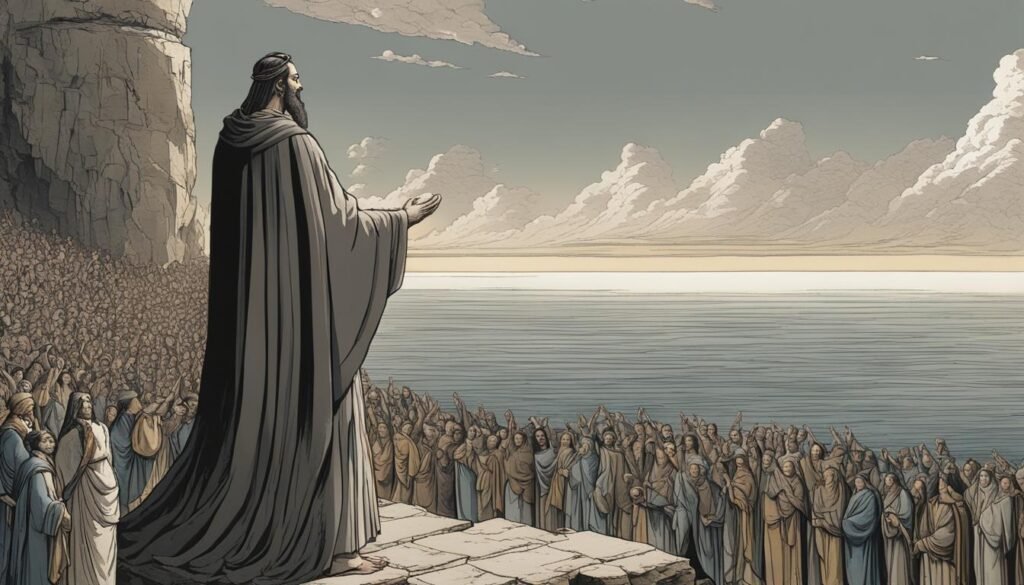Have you ever wondered about the physical appearance of biblical figures? One intriguing question that arises is the height of Moses. In this article, we will explore various sources and interpretations to shed light on this enigma.
Key Takeaways:
- The description of Moses as tall can be found in ancient and Talmudic sources.
- Symbolically, Moses’ height represents his spiritual greatness and perfection.
- Interpretations of Moses’ height vary, ranging from physical stature to spiritual significance.
- Considerations of Moses’ physical height allow for a deeper understanding of his significance.
- The focus in Jewish tradition is on spiritual height rather than physical appearance.
The Symbolic Meaning of Moses’ Height
The height of Moses mentioned in the Talmud holds a deeper symbolic meaning in Jewish tradition. Described as ten amos tall, this measurement represents perfection and completion. The number ten is associated with spiritual greatness, emphasizing Moses’ elevated status as a spiritual giant. It signifies that he reached the epitome of perfection in his character and deeds.
In contrast, Pharaoh is mentioned as being only one amah tall, representing absolute evil and the lowest mark on the spiritual scale. This juxtaposition highlights the importance of spiritual height over physical height in Jewish tradition. It teaches that greatness is not determined by one’s physical stature, but rather by one’s inner qualities and actions.
Every individual has the potential to grow spiritually and strive for greatness, regardless of physical stature.
This understanding emphasizes the height of one’s character and the depth of one’s spiritual connection, rather than focusing on external appearances. It encourages individuals to cultivate their inner selves and aspire to spiritual growth, regardless of their physical attributes. The symbolic representation of Moses’ height serves as a reminder that true greatness lies within and can be achieved by anyone who chooses to embark on a journey of self-discovery and spiritual elevation.
The Symbolic Meaning of Moses’ Height in Jewish Tradition:
| Moses | Pharaoh |
|---|---|
| Ten Amos Tall | One Amah Tall |
| Symbolizes spiritual greatness | Represents absolute evil |
| Emphasizes perfection and completion | Signifies the lowest mark on the spiritual scale |
| Focuses on inner qualities and actions | Highlights the limitations of physical stature |

Understanding the Interpretations of Moses’ Height
When exploring the topic of Moses’ height, it becomes evident that there are various interpretations and misinterpretations surrounding this aspect. One particular instance of misinterpretation is found in the Gemara, where Rav’s statement about Moses being ten cubits tall was misconstrued. Initially, it was mistakenly understood that Moses had an ordinary body with an exaggeratedly long arm. However, Rav clarified that he was referring to the cubit of the tabernacle, indicating that Moses had a physically imposing stature with proportionate limbs.
Nevertheless, this interpretation raises practical questions. How could Moses, with such height, have entered the tabernacle? This conundrum leads some scholars to propose an alternate interpretation, suggesting that the mention of Moses’ height holds a spiritual rather than a purely physical significance. The idea behind this interpretation is that Moses’ spiritual greatness was so immense that it was metaphorically represented by his physical height.
By adopting a spiritual versus physical interpretation, a deeper understanding of Moses’ significance can be achieved beyond literal physical measurements. It allows us to appreciate the symbolic representation of his towering spiritual character, which inspired awe and reverence in those around him. Furthermore, this perspective emphasizes the limitations of solely relying on physical interpretations and the importance of delving into the spiritual dimensions of biblical narratives.
FAQ
How tall was Moses according to ancient sources?
According to various ancient and Talmudic sources, there are indications that Moses was described as tall. Artapanus of Alexandria, a historian from the 3rd or 2nd century BC, described Moses as “tall and ruddy, with long white hair, and dignified.” Josephus, a Jewish historian from the 1st century AD, mentioned that Moses excelled in stature and beauty. Rabbi Shlomo Yitzchaki, also known as Rashi, mentioned Moses’ tallness in Talmud Berakhot. Even Abu Huraira, a companion of the Prophet Muhammad, described Moses as “dark-skinned and tall.” While these quotes are not authoritative, they suggest a tradition that Moses was indeed tall. The mention of Moses being “powerful in action” in the Book of Acts can also imply physical strength, possibly related to his height. Although these sources may not be entirely reliable, it is interesting to consider these descriptions when picturing Moses in biblical narratives.
What does the Talmudic description of Moses being ten amos tall symbolize?
The Talmudic description of Moses being ten amos tall holds a symbolic meaning. In Jewish tradition, the number ten is associated with perfection and completion. By describing Moses as ten amos tall, the Talmud emphasizes his greatness and holiness, suggesting that he reached the pinnacle of perfection. In contrast, Pharaoh is mentioned as only one amah tall, representing absolute evil and receiving the lowest mark on the spiritual scale. This highlights the importance of spiritual height over physical height in Jewish tradition. It is emphasized that every individual has the potential to grow spiritually and strive for greatness, regardless of physical stature. The focus is on the height of one’s character and deeds, rather than their physical appearance.
How can we understand the interpretations of Moses’ height?
The interpretation of Moses’ height as given by Rav in the Gemara provides insights into the challenges of understanding his physical stature. Rav initially stated that Moses was ten cubits in height, but was misinterpreted to mean that Moses had an ordinary body and his arm was exaggeratedly long. However, Rav clarified that he was referring to the cubit of the tabernacle, suggesting that Moses was physically imposing, with long limbs that were in proportion to his body. Nevertheless, this interpretation poses practical questions, such as how Moses could have entered the tabernacle with his height. Some scholars suggest that the mention of Moses’ height might have a spiritual connotation rather than a strictly physical one. The idea is that his spiritual greatness was so immense that it was metaphorically represented by his physical height. This interpretation allows for a deeper understanding of Moses’ significance beyond literal physical measurements.

I’m Benjamin, a passionate spiritual seeker and creator of Verses and Prayers. Alongside my girlfriend Emma and our pet lizard Mulle, I cherish family life, enjoy exploring new places, and am deeply involved in my church community. My love for reading and singing biblical verses inspires every aspect of my journey.

